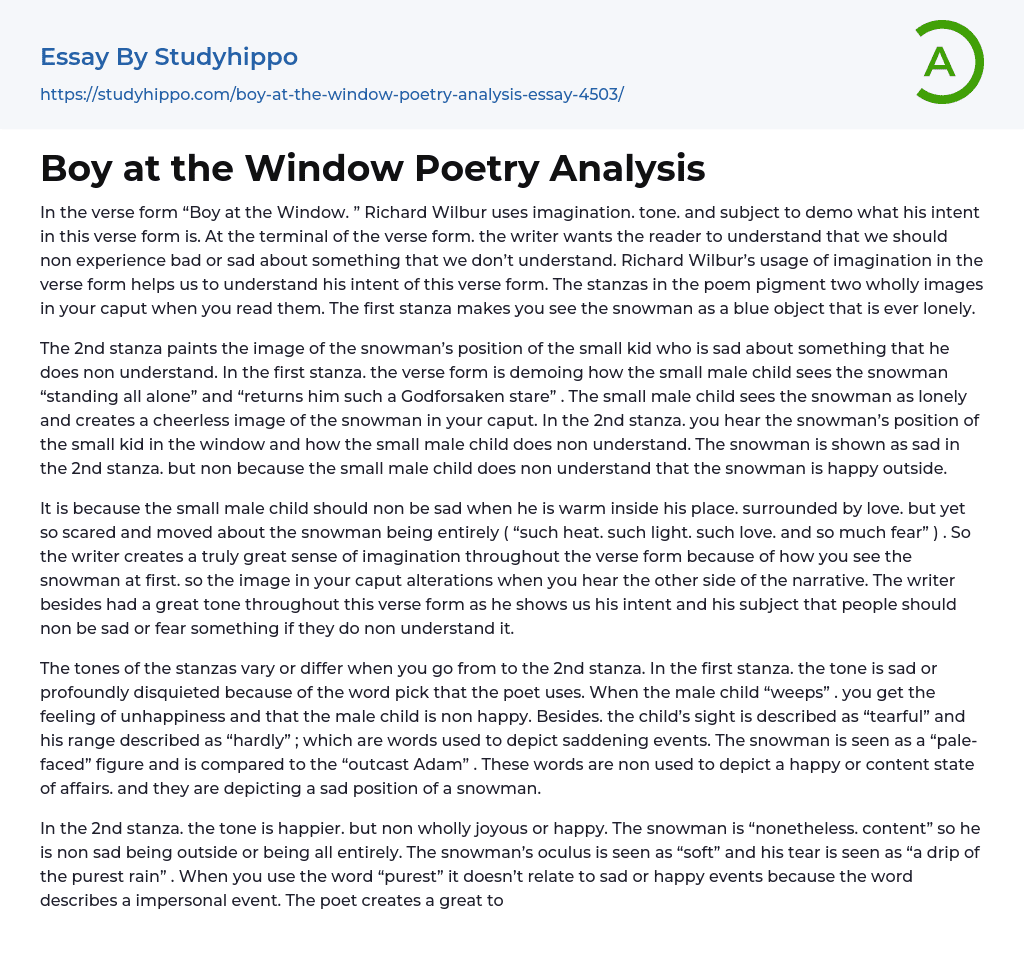In the verse form “Boy at the Window. ” Richard Wilbur uses imagination. tone. and subject to demo what his intent in this verse form is. At the terminal of the verse form. the writer wants the reader to understand that we should non experience bad or sad about something that we don’t understand. Richard Wilbur’s usage of imagination in the verse form helps us to understand his intent of this verse form. The stanzas in the poem pigment two wholly images in your caput when you read them. The first stanza makes you see the snowman as a blue object that is ever lonely.
The 2nd stanza paints the image of the snowman’s position of the small kid who is sad about something that he does non understand. In the first stanza. the verse form i
...s demoing how the small male child sees the snowman “standing all alone” and “returns him such a Godforsaken stare” . The small male child sees the snowman as lonely and creates a cheerless image of the snowman in your caput. In the 2nd stanza. you hear the snowman’s position of the small kid in the window and how the small male child does non understand. The snowman is shown as sad in the 2nd stanza. but non because the small male child does non understand that the snowman is happy outside.
It is because the small male child should non be sad when he is warm inside his place. surrounded by love. but yet so scared and moved about the snowman being entirely ( “such heat. such light. such love. and so much fear” ) . So the writer creates
a truly great sense of imagination throughout the verse form because of how you see the snowman at first. so the image in your caput alterations when you hear the other side of the narrative. The writer besides had a great tone throughout this verse form as he shows us his intent and his subject that people should non be sad or fear something if they do non understand it.
The tones of the stanzas vary or differ when you go from to the 2nd stanza. In the first stanza. the tone is sad or profoundly disquieted because of the word pick that the poet uses. When the male child “weeps” . you get the feeling of unhappiness and that the male child is non happy. Besides. the child’s sight is described as “tearful” and his range described as “hardly” ; which are words used to depict saddening events. The snowman is seen as a “pale-faced” figure and is compared to the “outcast Adam” . These words are non used to depict a happy or content state of affairs. and they are depicting a sad position of a snowman.
In the 2nd stanza. the tone is happier. but non wholly joyous or happy. The snowman is “nonetheless. content” so he is non sad being outside or being all entirely. The snowman’s oculus is seen as “soft” and his tear is seen as “a drip of the purest rain” . When you use the word “purest” it doesn’t relate to sad or happy events because the word describes a impersonal event. The poet creates a great tone throughout the full verse form. which is sad for the first
stanza and sort of impersonal for the 2nd stanza.
Using imagination. tone. and subject throughout the verse form “Boy at the Window” . Richard Wilbur shows that you shouldn’t experience bad or acquire upset about something that you do non understand. The author’s usage of imagination in the verse form is what paints a fantastic image in your caput as you read. and that helps you to understand the author’s intent. Tone plays a large function in the verse form besides because of the manner you get to hear the different sides to the narrative and how that impacts the author’s intent and how it’s portrayed. This verse form was really good written and did a really good occupation of utilizing literary elements to portray the author’s intent and the subject.
- Christina Rossetti essays
- Emily Dickinson essays
- Ernest Hemingway essays
- Percy Bysshe Shelley essays
- Robert Browning essays
- Robert Louis Stevenson essays
- Seamus Heaney essays
- Carol ann duffy essays
- Anne Bradstreet essays
- Elizabeth Bishop essays
- Peter Skrzynecki essays
- Poets essays
- Robert Frost essays
- Aldous Huxley essays
- Anton Chekhov essays
- Charles Dickens essays
- Edgar Allan Poe essays
- F. Scott Fitzgerald essays
- Harper Lee essays
- Homer essays
- Jane Austen essays
- John Steinbeck essays
- Kurt Vonnegut essays
- Mark Twain essays
- Mary Shelley essays
- Nathaniel Hawthorne essays
- Sophocles essays
- Stephen King essays
- William Shakespeare essays
- Zora Neale Hurston essays
- Amy tan essays
- Virginia woolf essays
- Alice Walker essays
- Chinua Achebe essays
- Sherman Alexie essays
- George Orwell essays
- Sylvia Plath essays
- T. S. Eliot essays
- W. H. Auden essays
- Wilfred owen essays
- William blake essays
- Kate Chopin essays
- Oscar Wilde essays
- Phillis Wheatley essays
- Ray Bradbury essays
- Richard Rodriguez essays
- Walt Whitman essays
- The Tempest essays
- Leonardo Da Vinci essays
- Thomas Hardy essays




